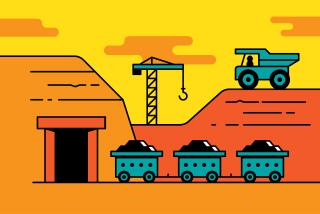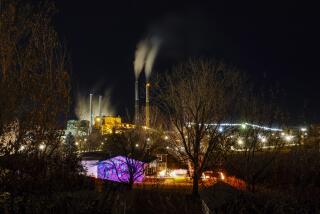A Copper Town Digs Out
MORENCI, Ariz. — The last time Roxanne Musser saw road work here was back in the mid-1990s, when the company that owns this copper mining town paved one dusty street after another, only to stop abruptly when the metal’s price tumbled.
So the 34-year-old homemaker knew exactly what it meant when construction crews appeared a few weeks ago on her corner and painted road signs and repaired the street.
“You could see that copper was back up,” says Musser, whose family has been connected to mining here for four generations. Her husband now works for town owner and employer Phelps Dodge Corp. “You know when copper’s good.”
Thanks to a near doubling of copper prices in the last year, largely because of booming demand from China, Morenci and other mining communities across the West are undergoing a modern-day gold rush. Companies that dig copper, silver and other minerals are boosting production, hiring workers and reopening decades-old facilities. Some are even proposing new mines, something that the long-ailing American copper industry hasn’t seen for a generation.
The revival of mining -- gold in Nevada, silver in Idaho, copper in Arizona, New Mexico and Montana -- is generating more high-paying jobs, spurring consumer spending and providing a shot in the arm to struggling rural economies. Like farming in the Midwest and textiles in the Southeast, mining in the West had been in decline for decades, the result of global competition and depressed prices. New technologies also have eliminated thousands of jobs.
The fact that the mining upturn owes its success largely to China illustrates an upside to globalization and increased trade with the Asian nation. China’s seemingly insatiable demand for metals for its expanding industrial base could help support American mining activity for years.
Although nobody is expecting a return to the industry’s heyday in the 1950s, people in mining are feeling more secure and hopeful than most can remember.
In Idaho’s Silver Valley, communities with names like Smelterville and Silverton have been grappling with double-digit unemployment for 20 years. But with silver prices up by more than 50% since June, Coeur Silver Valley Inc. says it is profitable again and is exploring for ore in northern Idaho. Its 165 workers got a bonus this year tied to silver prices. Another company nearby, Hecla Mining Co., is investing $8 million at its mile-deep Lucky Friday mine, with the goal of doubling its output and expanding jobs.
In Safford, Ariz., the seat of Graham County where some Pima cotton is grown, residents appear almost giddy about the prospect of Phelps Dodge digging two new open-pit copper mines along the foothills of the Gila Mountains. The project has been batted around for years, but the latest surge in copper prices and the company’s stepped-up efforts -- Phelps Dodge engineers recently occupied empty storefronts in Safford -- have heightened anticipation of hundreds of new jobs and millions of dollars pouring into the local economy.
Safford’s outgoing mayor, Van Talley, like others around here, checks the price of copper every day. About a third of the 2,050 miners at Morenci, home to the nation’s largest copper operation, live in Safford; many others shop in this town of 9,400. Car dealers and other merchants say business is hopping again.
Not long ago, “you could have shot a gun on Main Street and not hit a soul,” says Talley. Now, “it’s coming back.”
Just how long this excitement lasts is anybody’s guess. Copper booms are notoriously cyclical, with relatively short periods of upswings followed by long downturns. That’s because it takes a while for mining companies to ramp up production when times are good, and often they’re unable to adjust quickly when demand slumps, leading to a supply glut that drives down prices.
Copper was strong for about three years through mid-1997 amid lean inventories, then languished for the next six years. But since last spring, copper prices have soared to new highs, in recent weeks hovering around $1.35 a pound in global markets.
Although the strengthening U.S. manufacturing sector has helped, a key factor behind the run-up is China’s huge appetite for raw materials. China needs copper to supply its humming car and electronics factories, as well as for all the houses, dams and telecommunications systems that the country is building. U.S. producers of other commodities, including cotton and scrap metal, also are benefiting from China’s hearty consumption.
Globalization isn’t new for the mining industry, where demand, supplies and capital have been shifting around the world for more than a century. George Leaming, a Tucson-area consultant who has tracked mining for four decades, remembers when U.S. copper companies fell on hard times in the early 1980s and how Japanese investors, taking a long-term view, poured much-needed capital into some mining facilities in the West. Today, he says, “it’s China that’s coming rapidly into the industrial age, and they’re a major consumer.”
None of this is lost in the copper belt in southeastern Arizona, particularly at the Morenci mines, 85% owned by Phelps Dodge and 15% by Tokyo-based Sumitomo Corp. Workers here are acutely aware that even as competition from Chile’s high-grade copper mines pose a threat down the road, China’s purchases now are helping put bonus checks in their pockets, supplementing their salaries, which average about $40,000 a year.
Morenci is one of the last company-owned mining communities in America. Phelps Dodge began mining here in the 1880s, and for many years this was a “tent city,” where migrants from the Midwest and Mexico lived while they labored in the mines. (About half of the current workforce is Latino.) In the 1960s, the company began putting up simple wood-frame and brick houses on narrow arroyos and hillsides dotted with mesquite and prickly pear cactus.
In all, Phelps Dodge owns 1,132 houses in Morenci, rented to employees for usually $200 to $250 a month. About 90% are occupied. There’s not a whole lot more in town: the 20-room Morenci Motel, a gas station, medical clinic, a few churches and schools, the public swimming pool in the park and the local general store, known to old-timers as the Merc.
There’s no sit-down restaurant or Starbucks here. Some hang out at the 10-lane bowling alley, but many drive an hour west on weekends to the Safford area, where Morenci families run into each other at Wal-Mart and one of three Chinese buffets.
Others in Morenci like to hop in their trucks and go fishing. Fifteen minutes in any direction, locals say, takes them to rivers and lakes with catfish and smallmouth bass. Hunting grounds are nearby, too.
Almost everyone can tell a visitor the latest copper prices, which affect just about everything here: employee bonuses, where and how deep to dig, even whether the company holds its summer picnic or offers public tours of the facilities. The tours went away in 2001 when copper fell below 70 cents a pound, along with about 100 jobs at the plant.
Sixty-five cents is the danger zone. That’s how much it costs Phelps Dodge to make a pound of copper in Morenci. Hunter White, president of the Morenci operation, says the goal is 60 cents. To get there, he’s looking at everything: Can the 270-ton haul trucks squeeze a few more tons on their loads? Can they go a couple miles an hour faster?
As recently as the early 1980s, train-based shovels scooped up ore, hauled them to mills to be crushed, the contents then separated in a concentrator, smelted and refined. Crews spent the entire day just laying down and gathering up train tracks. In 1981, it took 3,400 workers to produce 292 million pounds of copper.
Last year, 2,050 employees churned out 842 million pounds. The trains have been replaced by monster-sized trucks, and Morenci extracts all its copper through a solution “leaching” process that has eliminated the need for a concentrator or for hot and sometimes-dangerous furnaces. In 2003, there were 42 mostly minor injuries at the Morenci operations -- a lower injury rate than for people working in grocery stores.
But such efficiencies may not be enough. White figures some mines in Chile, besides having richer copper ore, can make a profit at 50 cents a pound. At the moment, however, with prices where they are, things are looking up. Bonuses are back. Employment is stable and may even climb again at Morenci, White says, considering the possibility that copper may rise to $2 a pound.
“If China just continued to go gangbusters and India took off, who knows?” he says.
People in Morenci would go wild if that happened. When copper hit $1 a pound in December, workers were thrilled, if not somewhat in disbelief. Human resources representative Aimee Arrington saw the price flash on one of the company’s monitors, then raced back to her desk, checked the Internet and called her husband to ask: Did you see that? Can you believe it?
That same month, Lazaro Palomarez, an equipment operator who makes $16.83 an hour, went out and traded in his 10-year-old truck for a $27,000 red Chevy Silverado. “It should stay up for a while,” the 61-year-old says of copper prices. “They said the market is good. China and Korea are buying a lot of copper.... We got the product they want.”
Roxanne Musser and her husband, Brian, who manages environmental services at the mines, just bought a new vehicle, too -- a Toyota sedan, which was parked in their driveway next to a bed of daffodils. The Mussers said it was time to replace the family car, not a knee-jerk reaction to the copper market. Then again, it was hard for them to deny a connection.
As a native here, Roxanne knows well that time and money -- indeed, life itself -- could be measured by the price of the red-colored metal. She recalled one year of soaring prices in the late ‘70s when Christmas brought a parakeet for her, a cat for her sister and a dog for her brother. When the lean years came soon after, socks and necessities were under the Christmas tree, and the men of the house were off hunting to put deer meat in the freezer.
In 1989, working as a clerk at the Merc, she could see that copper was king again when people were snapping up washers and dryers -- on company credit. And in 1995, the year she and Brian got married and copper prices averaged $1.33 a pound, everybody in town seemed jubilant, the roads were being paved and the parks were getting cleaned. Then the long chill set in.
And now?
“Who knows to say how long this will last,” she says. “Hopefully for a while. You enjoy it while it’s here because you know there’s going to be a downturn.”
More to Read
Inside the business of entertainment
The Wide Shot brings you news, analysis and insights on everything from streaming wars to production — and what it all means for the future.
You may occasionally receive promotional content from the Los Angeles Times.











